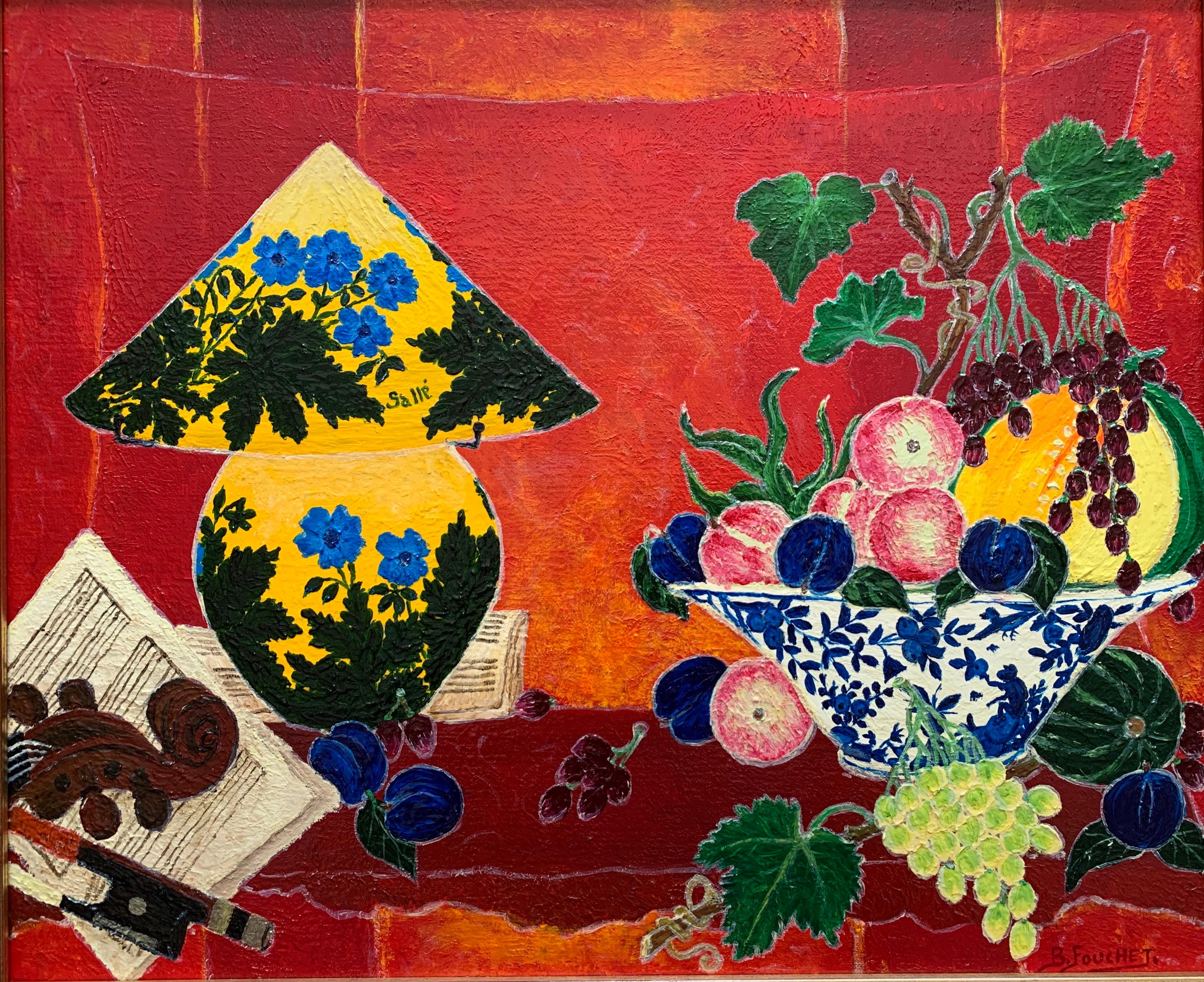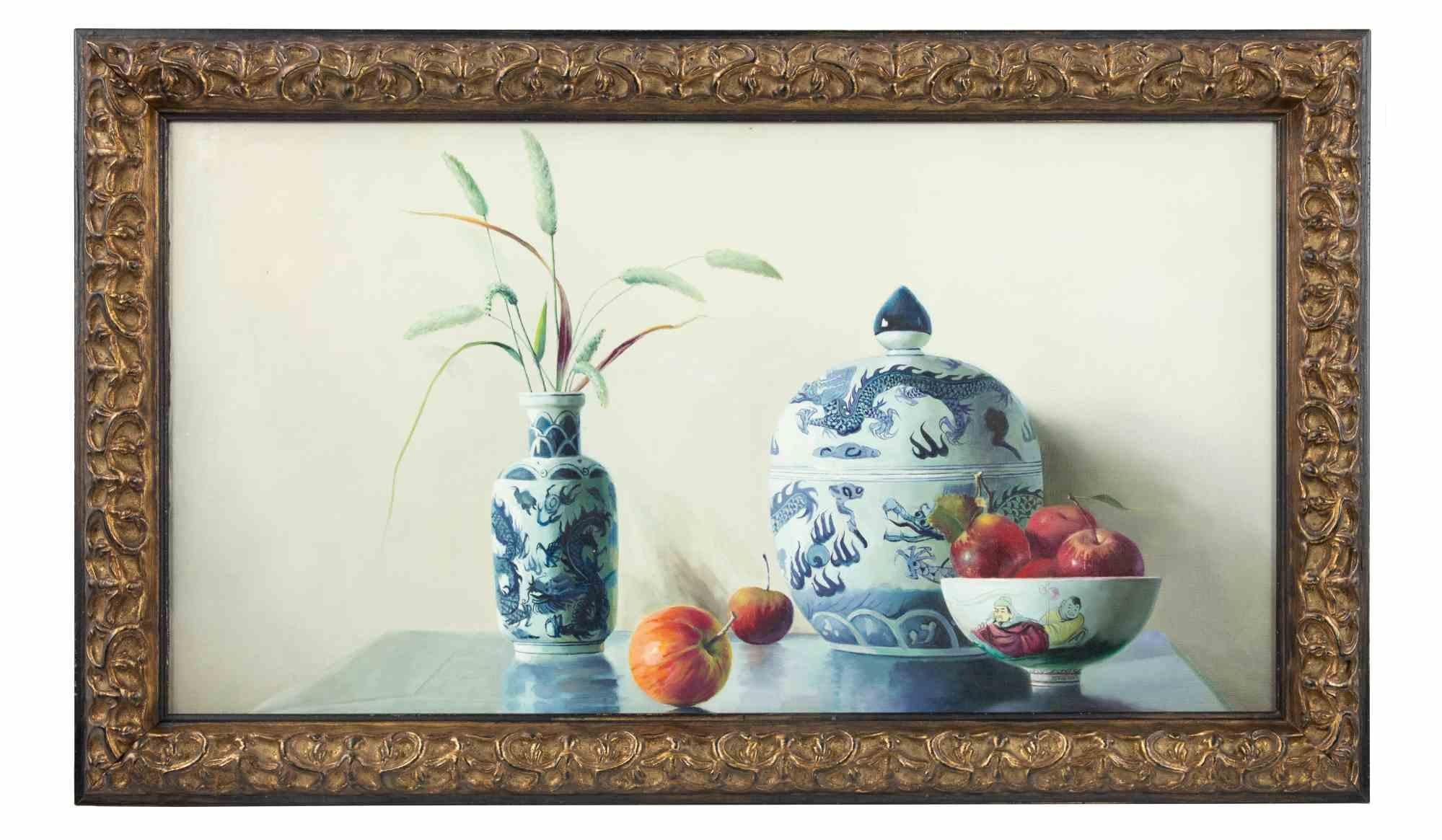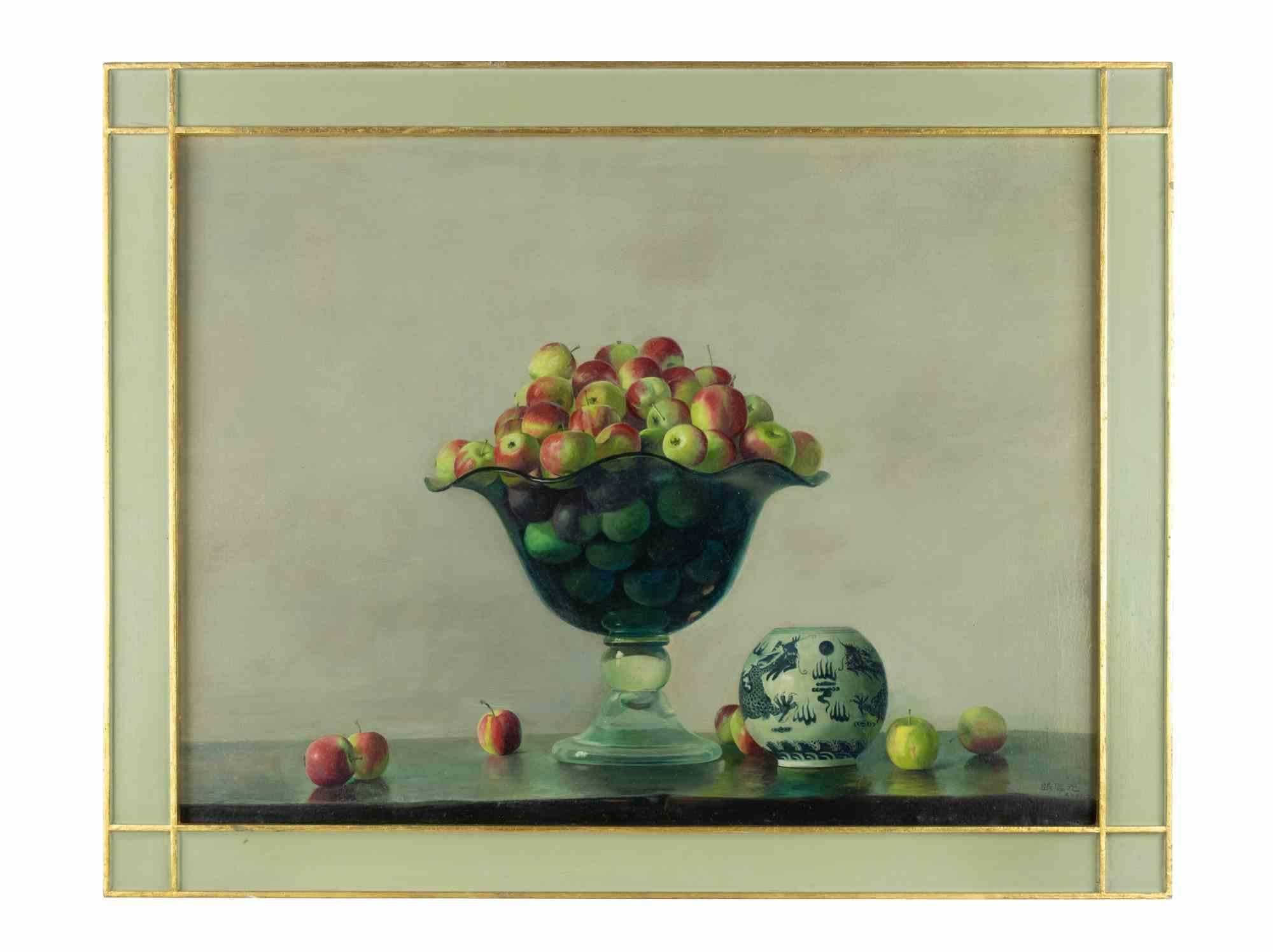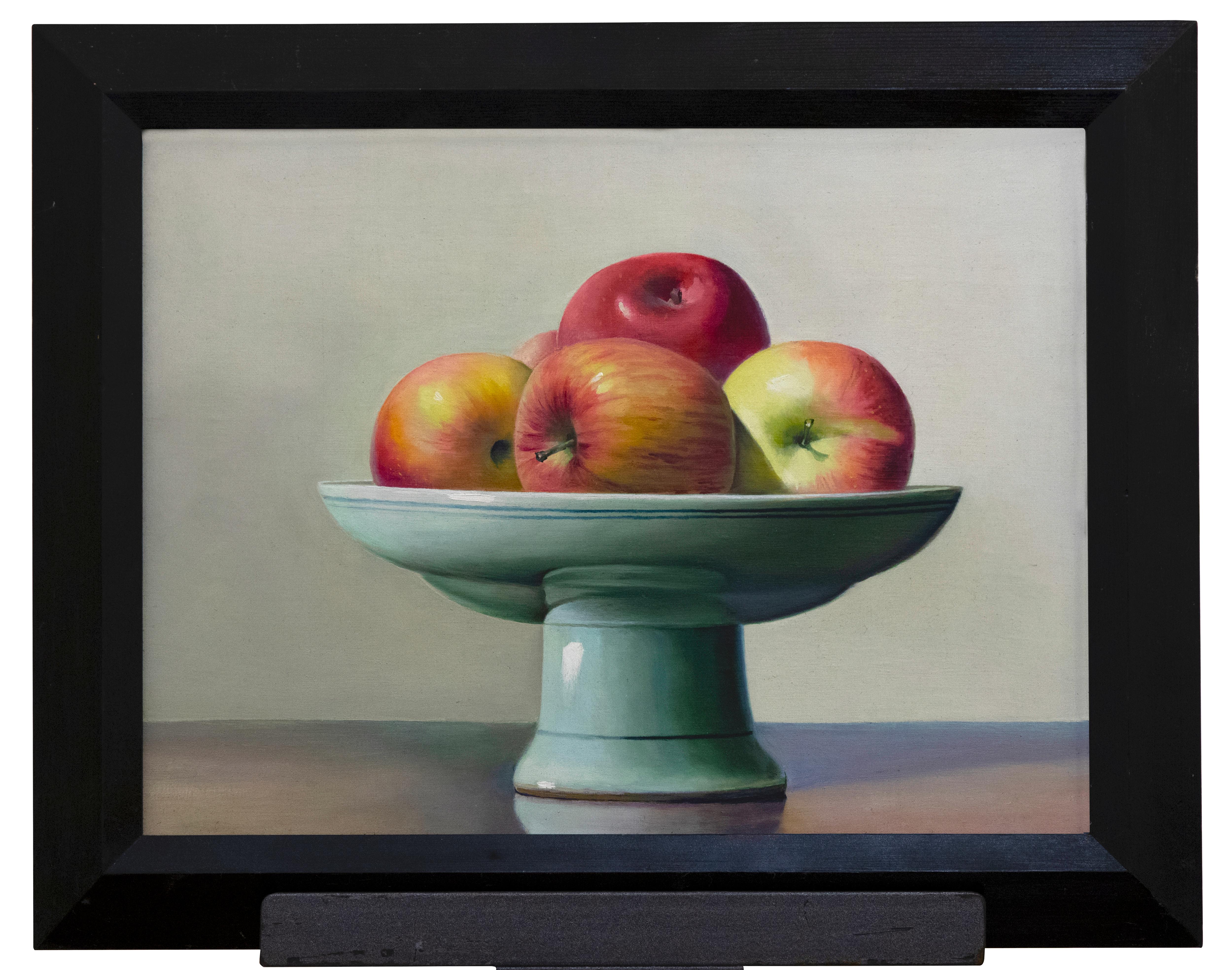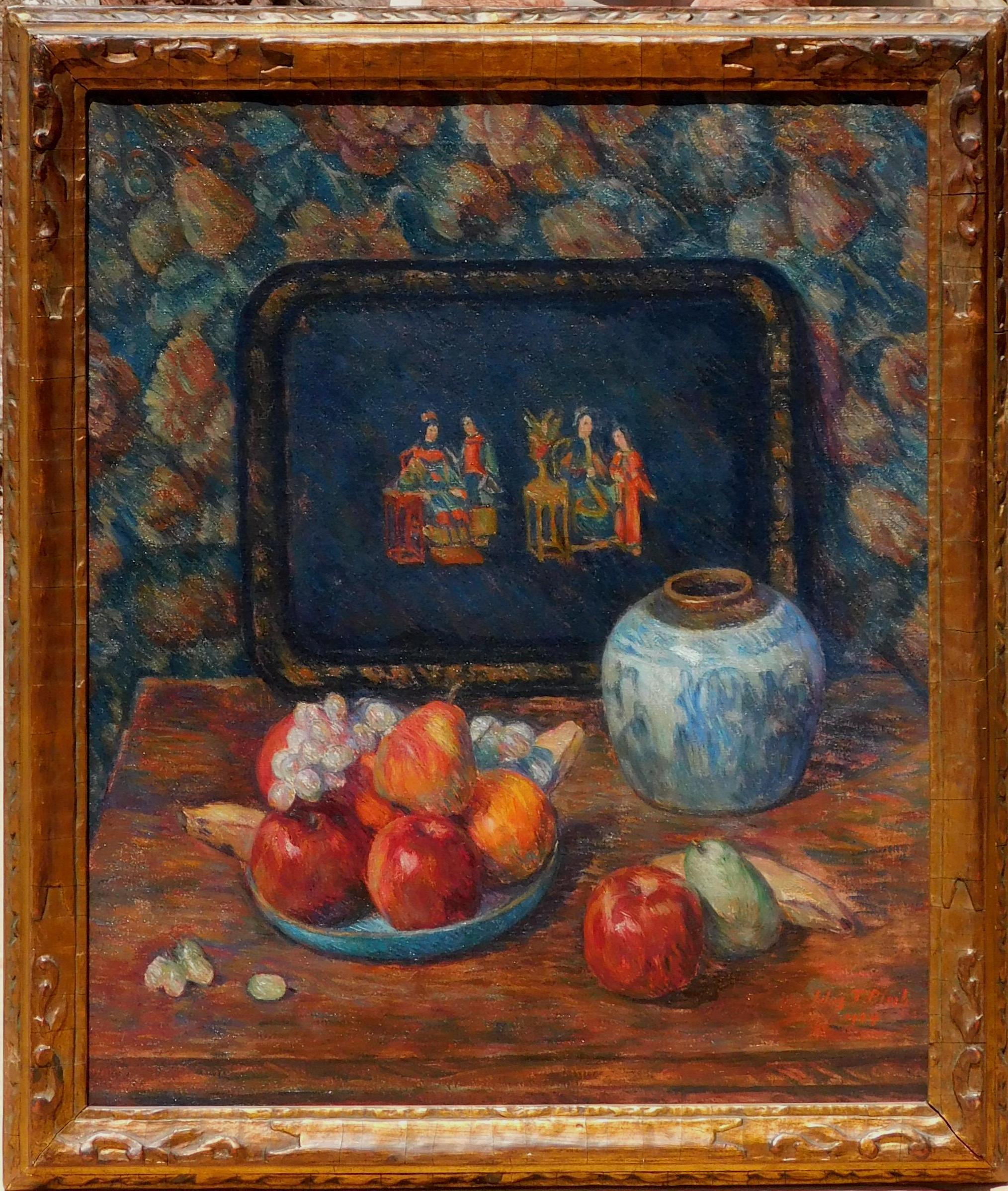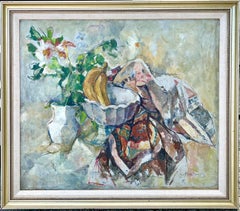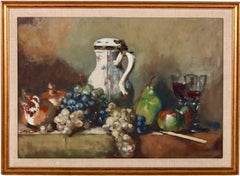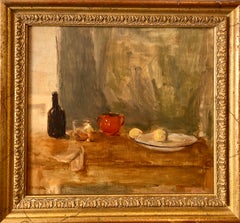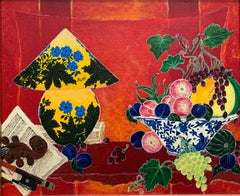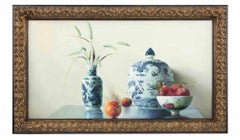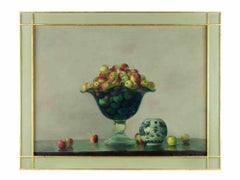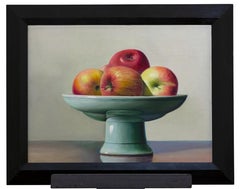Items Similar to Japanese Fauvist Colorful Oil Painting Chinese Ceramic Jars with Fan and Apple
Want more images or videos?
Request additional images or videos from the seller
1 of 14
Yoshio AoyamaJapanese Fauvist Colorful Oil Painting Chinese Ceramic Jars with Fan and Apple1981
1981
$2,600
£1,965.28
€2,258.45
CA$3,620.48
A$4,027.64
CHF 2,111.34
MX$49,216.78
NOK 26,885.27
SEK 25,308.77
DKK 16,858.50
Shipping
Retrieving quote...The 1stDibs Promise:
Authenticity Guarantee,
Money-Back Guarantee,
24-Hour Cancellation
About the Item
Yoshio Aoyama (Japanese, 1894-1996) "Nature Morte". Oil on canvas. 1981. Signed 'Aoyama' (upper left). Signed and titled 'Nature Morte' verso. 15" x 18" without the gold gilded frame.
Yoshio Aoyama is a character of great importance in painting of the early twentieth century in France, little known in the history of art, Aoyama was studied by the Spanish historian Luis Pérez Nieto, given his friendship with the widow of the artist, Marie Madelaine Lyvan.
Aoyama has a totally different style of painting than his Japanese predecessors like the painter Fujita, following a different path, because instead of introducing recognizable Japanese elements into his work, Aoyama chose to use them in a subtle way all along of her career. He never wanted to give up their tradition, yet Aoyama was able to adapt to Western culture by becoming an important part of the history of French painting of the twentieth century, forming part of the School of Paris .
Because of its longevity (Yokosuka 1894 - Tokyo 1996), Aoyama's work spans most of the twentieth century. One could say that in his painting there is an abstraction of a certain ideal transmitted by his ancestors, an ideal that manifests itself in the "joie de vivre" which is also present in painters like Pierre Bonnard , Raoul Dufy or his master Henri Matisse .
Aoyama's style discovers a law that gives constant power and great intensity. A beach, a garden, a street. these scenes are adapted to his own vision of the world full of spiritual values from their Eastern roots. There is a double choice: on the one hand the characters, and on the other hand the spiritual objective.
The first stage of formation of Yoshio Aoyama took place under the influence of the Japanese master Oshita Tojiro in 1911, Aoyama becomes orphan of father and mother, adopted by Tojiro like son and like apprentice. He was admitted in the school Nihon Suisaiga Kenkyusho .
From an early age, he devoted himself entirely to painting, in a quasi-self-learning. After he studied Fine Arts at the University of Tokyo.
His first teacher was Oshita Tojiro of a Western style, watercolor specialist (being promoter of the art magazine Mizu-e). This internship at the Tojiro workshop was devoted to copying classical studies and nudes and landscapes. He received a solid background in Western art and drawings, made with a firm and secure line.
His early works show a thick oil traits, typical of his training as an artist, which define the outlines, and a range of dark Asian colors such as brown, green, brown, ocher ... that give a cold melancholy to the first step of Aoyama.
At other times in its first phase the colors make the limits of the figures, creating very marked and delimited shapes, with a lack of color mixing. A technique that is linked to the traditional Japanese Oriental painting Ukiyo-e , literally ' floating painting' , where the backgrounds are completely flat and the figures seem to float on stage. There is also a clear influence of the kano- style screens and the screens of the Namban period ( 16th - 17th centuries). In this type of Japanese screens appear funds with golden clouds that fill the scenes with a mystical air.
Yoshio Aoyama came to Europe to complete their training. The passion for Europe was inherited from his father, who came from a samurai family who became secretary of the Japanese Navy Ministry. It was his father who instilled in him the love of travel and visiting foreign countries. The first European city where he settled was Paris, recommended by one of the first collectors, the Japanese Fukushima. Moreover, Paris was the capital of the world of art, where he had the seat of an international community called School of Paris created in 1910 by artists such as Raoul Dufy , the Spaniard Pablo Picasso, the Italian Amadeo Modigliani, the Belarusian Marc Chagall and of course the Japanese and the great ambassador of oriental art Tsuguharu Fujita, and the disciple of Renoir who Aoyama met in this period, the Japanese Ryuzaburo Umehara.
The School of Paris, located in the bohemian quarter of Montmartre, could be considered a real artistic tower of Babel, where mixed styles as diverse as Cubism, Modernism, Futurism, Primitivism etc. but with common features like fascination for the exotic, colorful. So Aoyama has come into close contact with the European avant garde.
After his stay in Paris, he decided to move, for health reasons, to a warmer place, the capital of the French Riviera, Nice. Aoyama continued his painting, and it was at one of his exhibitions that he met Henri Matisse. Matisse fascinated by his color, calmed calling Aoyama a marvelous colorist. Yoshio Aoyama becomes a disciple of the great French master. From 1926, his lessons with Matisse made a big change in the technique used. He began to create a new style full of originality, to recreate a fascinating and impressive world. Now, his figures will acquire the volume and the depth of the compositions. There is the impression of an eternal flux, the figures belong to his works, there is a superior Being who directs everything. It gives them a sense of lyricism, poetry awash with a certain mystery that is still incomprehensible to the viewer. This change in Aoyama painting is being done gradually, in the precepts of Fauvism, leaving behind their Japanese tradition. Now, the colors pink and blue are a constant in his work. This step is still a step in forming a personal style.
Bibliography
Dictionary Bénézit , Critical and documentary dictionary of painters, sculptors, draughtsmen and engravers of all times and all countries , vol. 1, Gründ editions
(es) Luis Pérez Nieto, Yoshio Aoyama. A painter of european inspiration.
(in) Roberts, Laurence, P., A dictionary of japanese artists: paintings, Scultures, Ceramics, Prints and Lacquers. , Weatherhill New York, 2000
About the Seller
4.9
Platinum Seller
Premium sellers with a 4.7+ rating and 24-hour response times
Established in 1995
1stDibs seller since 2014
1,784 sales on 1stDibs
Typical response time: <1 hour
- ShippingRetrieving quote...Shipping from: Surfside, FL
- Return Policy
Authenticity Guarantee
In the unlikely event there’s an issue with an item’s authenticity, contact us within 1 year for a full refund. DetailsMoney-Back Guarantee
If your item is not as described, is damaged in transit, or does not arrive, contact us within 7 days for a full refund. Details24-Hour Cancellation
You have a 24-hour grace period in which to reconsider your purchase, with no questions asked.Vetted Professional Sellers
Our world-class sellers must adhere to strict standards for service and quality, maintaining the integrity of our listings.Price-Match Guarantee
If you find that a seller listed the same item for a lower price elsewhere, we’ll match it.Trusted Global Delivery
Our best-in-class carrier network provides specialized shipping options worldwide, including custom delivery.More From This Seller
View AllPost Impressionist Oil Painting Still Life with Fruit William Meyerowitz WPA Art
By William Meyerowitz
Located in Surfside, FL
William Meyerowitz (1887 - 1981)
Oil painting on canvas
Depicting a still life scene with fruit bowl, bananas, flowers and quilt. Post Impressionist oil painting.
Hand signed low...
Category
1930s American Modern Figurative Paintings
Materials
Oil, Canvas
American Impressionist Fruits Oil Painting Vivid Apples and Grapes
By William Schultz
Located in Surfside, FL
William J. Schultz, American (1919 - 2005)
William J. "Bill" Schultz had been a renowned American Impressionist artist and teacher for over sixty-five years.
Co-Founder, and Director of the AIS had inspired numerous professional artists and teachers through his teaching. He also was a Master Pastelist in the Pastel Society of America and had won many awards for his oil and pastel paintings.
Born in Pittsfield, Massachusetts in 1919, he died in Vero Beach, Florida in 2005. He served in the Army in World War II including duty in Europe. He was discharged in 1946 with rank of First Sergeant. Schultz began his art studies with Martin C. Hoy, a fine artist and student of Robert Henri and William M. Chase. He graduated from The Vesper George School Of Art in Boston, Massachusetts in 1949. He then studied under National Academicians Jerry Farnsworth, Ivan Olinsky (a student of John Singer Sargent) and Robert Brackman. Winner of many awards for oil and pastel works. Was a noted portrait artist.
He was a founding Director of the American Impressionist Society and an award winning member of the Pastel Society Of America. He studied under notable National Academicians Robert Brachman, Ivan Olinsky and Jerry Farnsworth.
Schultz opened his own art studio and school in Lenox, Massachusetts and taught impressionist painting to hundreds of students, some of whom are now nationally recognized themselves. After 25 years at that location Schultz and his wife moved to Vero Beach, Florida where he continued to teach, as well as provide lectures and exhibitions around the country.
Illustrated articles about Schultz and his work have appeared in "American Artist", "Southwest Profiles", "Artists Of Florida" and other periodicals.
For a short time he studied alongside Norman Rockwell at a studio in Stockbridge, Massachusetts where Rockwell had established the base for his illustration work. Schultz was the proud possessor of an autographed sketch of himself that Norman Rockwell had created and was signed by Rockwell.
Schultz's art has been exhibited in museums and galleries in Boston, New York City, Sante Fe, and numerous Florida locations...
Category
20th Century American Impressionist Interior Paintings
Materials
Canvas, Oil
George Deem Appropriation Oil Painting Still Life, fruits, Grapes, Pomegranates
By George Deem
Located in Surfside, FL
George Deem (American, 1932-2008)
Oil painting on wood board
Depicting a still life arrangement with grapes, pears, and a pomegranate alongside a white ceramic pitcher and wine gla...
Category
1960s American Modern Still-life Paintings
Materials
Oil, Wood Panel
Seymour Remenick Still Life Table Scape Oil Painting with Bottle and Fruit
By Seymour Remenick
Located in Surfside, FL
Frame measures 13.75 X 14.75, board measures 11 X 12 inches
Seymour Remenick (1923-1999) American; Philadelphia, PA. Oil on canvas painting Folk Singers and musicians.Seymour Remeni...
Category
Mid-20th Century American Modern Figurative Paintings
Materials
Oil, Board
Vibrant Floral Still Life Painting in the Modernist Style
By Donald Roy Purdy
Located in Surfside, FL
DIMENSIONS: (With Frame) H:36" L:29 7/8" (Without Frame) H:29.5" L:23 3/8"
Donald Roy Purdy is an American painter whose work evolved through a range of styles and subjects over the course of his long career.
Born in 1924, the self-taught artist seldom used models. Rather, Purdy worked largely from the memory and impressions certain subjects and objects left upon his mind. The artist only occasionally paints on canvas, preferring masonite which he considers to be a stronger and longer-lasting material. Though he admits to using gesso, Purdy is known for his special preparations of painting surfaces through a method he keeps secret.
Purdy first began painting in an abstract style. He later combined the abstract techniques with representational subject matter, and would continue experimenting with new styles. In the 1970s and early 1980s, Purdy became influenced by the palette of the Barbizon painters and developed a unique approach, melding abstraction with the rigid Realist techniques to produce his signature Impressionist style.
Before pursuing a career as an artist, Purdy earned a B.A. from the University of Connecticut and an M.A. in Psychology from Boston University.
Two Purdy paintings were included in the US State Department's "Art in America" show which recently toured Europe and several "First Awards" have been given to Purdy in competition with major artists. Among these is the Gold Metal of Honor from the National Academy in New York City.
Purdy's pieces are exhibited by the noted Van Diemen-Lilienfeld Gallery, which shows his work alongside the works of Vlaminch, Derain, Pissaro, Monet, Chagall and Picasso. His one man exhibitions have been seen in New York at the Ruth...
Category
20th Century Still-life Paintings
Materials
Acrylic, Board
Fruit Still Life Oil Painting Betsy Podlach American Post Feminist Modernist Art
By Betsy Podlach
Located in Surfside, FL
Betsy Podlach (American, born 1964.)
Still life with Fruit and Glass Bottle
Framed it measures 26.5 X 21.5 Canvas is 21.5 X 16.5
Betsy Podlach graduated from Harvard, cum laude, (she studied at Harvard with Alfred Decreido and William Reimann as well as Carlos Fuentes continuing her studies at the New York Studio School of Drawing, Painting, and Sculpture, Ms. Podlach was awarded an art fellowship and residency at The International School of Art in Umbria, Italy.
Betsy Podlach is an American painter who considers the Italian Venetians and the american abstract expressionist painters her mentors. The two painters she is most inspired by are Titian and Jackson Pollock, Both use the picture plane and abstraction and space, light, movement and form to communicate a physicality built entirely on the principals of painting, in the “classical” sense of a flat plane and lines, color, shape, space and light applied to that flat surface to create magic – light, space, form, emotion, force, movement, the physical and the spiritual. She describes her work as a figurative version of abstract expressionism. She was influenced by many of the abstract expressionists from the NY school...
Category
1990s American Impressionist Figurative Paintings
Materials
Canvas, Oil
You May Also Like
Bright & Colorful French Modernist Signed oil Oriental Lamp Bowl of Fruit
Located in Cirencester, Gloucestershire
"Ambiance a la Lampe Galle"
by Bernard Fouchet (French 1932-2013)
signed lower corner, titled verso
in original frame with the artists monogram as part of the moulding
canvas: 15 x 18 inches
framed: 24 x 27 inches
provenance: private collection, France
Absolutely beautiful original painting by Bernard Fouchet (French 1932-2013). The work is signed to the front and back and titled verso too. Very rarely, it looks like the frame was custom made for or by the artist - as the monogram of BF is part of the moulding.
The painting radiates colour and vibrancy, with this eclectic mix of still life objects on a table, set against this red/ orange backdrop of colours. Beautiful.
Condition report:
the painting is in very good condition. The frame has a couple of 'nibbles' to the corners but is fine.
Bernard Fouchet was born in Cerdon-du-Loiret, France. He was the student of Augustine Memin who worked with Utrillo and Alfred Chagniot...
Category
21st Century and Contemporary Modern Interior Paintings
Materials
Canvas, Oil
Vases and Fruits - Oil Painting by Zhang Wei Guang - 2006
By Zhang Wei Guang
Located in Roma, IT
Vases and fruits is an original oil painting realized in 2006 by Zhang Wei Guang (Mirror).
Beautiful oil painting on canvas.
Includes frame.
Hand-signed and dated on the back
Zh...
Category
Early 2000s Contemporary Still-life Paintings
Materials
Oil, Canvas
Crystal Vase with Apples - Oil Painting by Zhang Wei Guang - 2001
By Zhang Wei Guang
Located in Roma, IT
Multi-coloured apples fill an elegant crystal vase situated on a smooth surface. This vase is the heart of the composition and it captures the attention of the beholders with its met...
Category
Early 2000s Contemporary Still-life Paintings
Materials
Oil, Canvas
Still Life with Apples - Oil on Canvas by Zhang Wei Guang (Mirror) - 2000
By Zhang Wei Guang
Located in Roma, IT
Original oil on canvas realized by Zhang Wei Guang in the early 2000s.
Signed on rear.
In excellent conditions, it includes a contemporary black wooden frame.
Zhang Wei Guang, als...
Category
21st Century and Contemporary Realist Still-life Paintings
Materials
Oil
Still life with apples 1961. Canvas, oil, 50x70 cm
Located in Riga, LV
Still life with apples
1961. Canvas, oil, 50x70 cm
Published at book Biruta baumane on 78 page
"Still Life with Apples" is a stylized still life pain...
Category
1960s Fauvist Still-life Paintings
Materials
Oil, Canvas
$4,599 Sale Price
20% Off
Still Life Painting - Chinese Tray with Fruit
By Julius Bloch
Located in Phoenix, AZ
Julius Bloch (1888-1966) German/American painter - Lovely Still Life Oil on Canvas.
Created in the 1920's, this lovely work features a Chinese Tray with Blue and White Pottery and fr...
Category
Early 20th Century Still-life Paintings
Materials
Canvas, Oil
More Ways To Browse
Japan Gold Painting
Japanese Gold Paintings
Picasso Japan
Blue Apples
Pablo Picasso Oil On Canvas
Japanese Step
Apples Oil Painting Framed
Oriental Painting
French Quarter Painting
Fauvist Style Paintings
Japan Hand Painted China
Chagall Oil Paintings
Japanese Fans
Benezit Painting
Vintage Chinese Oil Painting
Japanese Fan Art
Chinese Fans
Jar Paris
